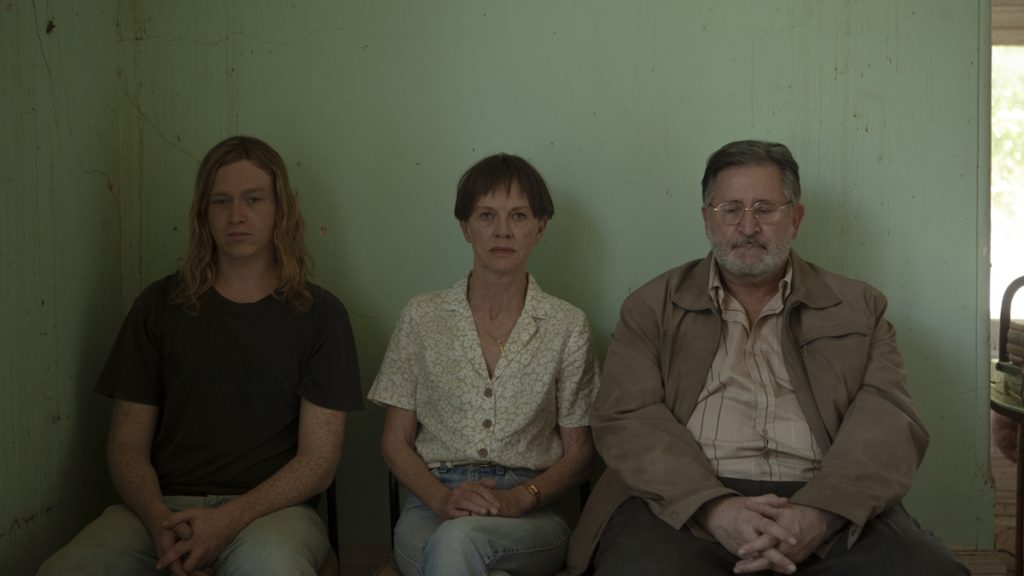Read also:
How to Watch FX Live Without CableHow To Watch AMC Without CableHow to Watch ABC Without CableHow to Watch Paramount Network Without CableJustin Kurzel’s latest showcases an incredible Caleb Landry Jones performance.
Justin Kurzel’s Nitram rarely features violence. Instead, it’s often subdued in anger, existing in long stretches of loneliness and isolation. The tone follows its lead, played by a phenomenal Caleb Landry Jones. He wanders through a small Australian town without friends or steady way to spend his time outside of fireworks. He exists in a muted state of prolonged sadness, taking enough medication to dampen his emotions. He’s unable to make any lasting relationships. Kurzel’s film, based on the 1996 mass shooting in Port Arthur, Tasmania, simmers towards an inevitable conclusion, constructing and examining the events leading to a tragedy, frightening in its intimacy.
The subject matter of Kurzel’s film, written by Shaun Grant, usually examines the “after” of an event of this magnitude. Or, films look at the days, hours, and minutes leading up to the violence. Nitram takes a different approach, the long view. It looks at its character for the years preceding his obsession with guns and his disillusion due to the deaths of his father (Anthony LaPaglia) and his only friend, Helen (Essie Davis), the only positive relationships in his life. Kurzel captures how these events push Nitram deeper into his own mind. They magnify his feeling of abandonment, his solitude.

Jones holds together the film as the bleary-eyed Nitram, a young man unable to comprehend his own issues. Early on, someone asks him, “Are you sick?” He responds by saying, “No, I just get sad sometimes,” an apt summarization of how he thinks of himself, someone with little joy in his life. Jones inhabits the facets of Nitram in full force, looking committed to the intensity that bubbles until it cannot stay capped any longer. It is then he explodes, only for a second, then rapidly receding back to this scared, angry, confused man. The actor embodies the character with the assurance of someone who has been a leading man for decades. He’s tremendous. It should earn him more top-billed roles in the future, a good development for him and independent film as a whole.
Jones inhabits the facets of Nitram in full force, looking committed to the intensity that bubbles until it cannot stay capped any longer.
Kurzel’s film is often heartbreakingly empathetic towards Nitram when it could be judgmental. Reckoning with one of Australia’s darkest days, the film takes on a level of measured understanding, knowing that horrifying events are drawing close to fruition. It never shows too much, refusing to buy into the idea that violence must be seen to be real. Instead, the film relies on only one of Nitram’s outbursts towards his father, captured in a single, harrowing, extended familial scene.
The film’s third act acts as an indictment of the ease with which Nitram stockpiled these weapons. Following his father’s funeral, another shattering moment in a movie full of broken pieces, Nitram goes to buy a gun. We observe as he’s unimpeded by background checks, registrations, or general laws. He acquires them from stores, other enthusiasts, and anyone else willing to sell them. Quickly, he has a small armory and an ever-increasing knowledge base about each of these firearms.

The speed of this stockpile amazes and horrifies. With a bit of money, anyone could gain access to these guns with little to no roadblocks in their way. As Nitram walks through a gun store, pointing these firearms at the clerk and other shoppers, the film shifts from unknowing to prescient, from harmful to harrowing. It’s a condemnation of these policies, or lack thereof, in Australia and throughout more of the Western world, specifically the United States.
Kurzel’s film wouldn’t work without Jones, though, despite the director’s commitment to keeping the film small and personal. The Australian filmmaker keeps the scope reined in, placing many of the movie’s scenes in the confines of one of several homes and their surrounding properties. Nearly every scene has Jones in the foreground or background. Viewers see the film through his eyes, strained and sensitive, filled with exasperation. He draws out more than just the usual sympathies, only to rip apart the audience’s hopes even if they know where the story is heading. He’s more than just believable; he’s unshakable. His face becomes a lasting memory for a film full of dread and distance.
Nitram is in theatres now.